The right chord progressions can make your entire track pop and help you really blow the competition away (they’re building blocks, so to speak).
And major chords, as opposed to minor chords, are all about creating bright, uplifting, and powerful sounds that get people hyped up.
As producers, using a major chord progression chart can really enhance your workflow and expand your creative potential all day long.
Plus help you up your theory game a little bit too, and that’s always a good thing.
So today, I’m breaking down everything you need to know about major chord progressions (and using a major chord progression chart), including:
- Major vs. Minor Chords: Key Differences ✓
- Using a Major Chord Progression Chart ✓
- Building Your Own Major Chord Progressions ✓
- Common Piano Chord Progressions ✓
- How to Use Diatonic Major Chords ✓
- Adding Flavor with Diminished Chords ✓
- Inversions for Smoother Transitions ✓
- Modulating Between Major Keys and Minor Keys ✓
- Extending Piano Chords & how to play chords like a boss ✓
- Advanced Production Tips & Techniques ✓
- Major scales vs minor scales & the Roman numeral system ✓
- Much more about using a major chord progression chart ✓
After, you’ll know everything about major chord progressions and how to use them to create some really interesting combinations.
Plus, you’ll learn how to successfully build, modify, and produce chords like a boss.
This way, you can knock out more polished tracks and use a major chord progression chart whenever you’d like.
Table of Contents
- What is a Major Chord Progression Chart?
- Structure of a Major Chord Progression
- Major Chords vs. Minor Chords: Breaking Down the Differences
- Using A Chord Progression Chart
- Popular Chord Progressions in Major
- #1. The I-IV-V Chord Progression
- #2. The I-V-vi-IV Chord Progression
- #3. The I-vi-IV-V Chord Progression
- #4. The I-IV-vi-V Chord Progression
- #5. The I-IV-ii-V Chord Progression
- #6. The I-iii-IV-V Chord Progression
- #7. The I-V-IV-V Chord Progression
- #8. The I-V-I Chord Progression
- #9. The I-vi-ii-V Chord Progression
- Creating Your Own Major Chord Progressions (Key Steps)
- Bonus #1. Layering Major Chords with Pads or Synths
- Bonus #2. Extending Major Chords for Show-stopping Sounds
- Major Chord Progression Chart: Final Thoughts
What is a Major Chord Progression Chart?
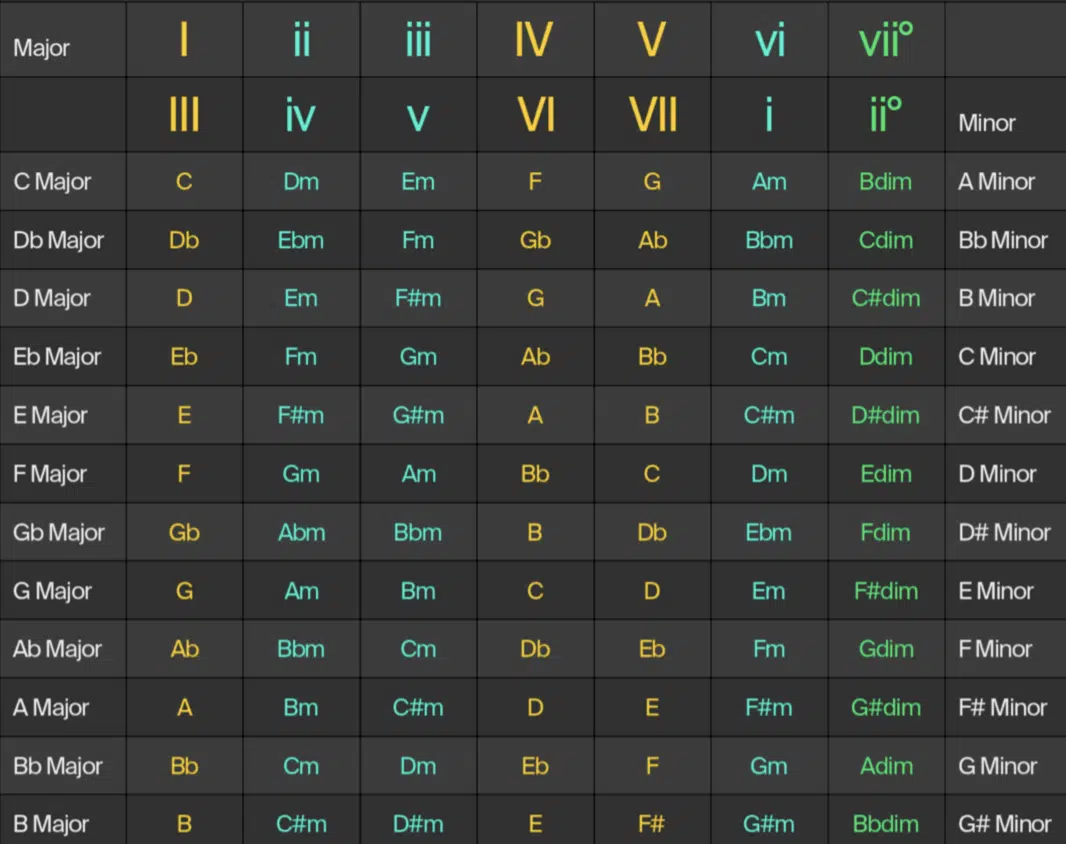
A major chord progression chart can help you quickly understand how major chords flow within a key, making it easier to lay down:
- Melodies
- Harmonies
- Complete tracks
It visually maps out the relationships between chords using Roman numerals (I, ii, iii, IV, V, vi, vii°) to represent each scale degree.
For example, in the key of C Major, the I chord is C Major, the IV chord is F Major, and the V chord is G Major.
A major chord progression chart isn’t just a reference; it’s a creative tool that helps you experiment with different combinations and variations.
Let’s say you’re working on a pop beat…
Using a chart like this, you might try a chord progression like C-G-Am-F (I-V-vi-IV), a classic pop pattern that creates a familiar yet super uplifting vibe.
Personally, I’ve found these charts useful when I’m looking to add new flavors to my tracks, especially during quick production sessions when I’m feeling stuck.
If we’re talking beat-block, it’s a life-saver in my opinion.
You can modify these chord progressions with inversions or extensions to add a fresh twist, like turning C Major into Cmaj7 to give it a smoother, classy vibe.
In today’s article we’ll not only break down how to use major chord progression charts, but also the basics of major chords as a whole, so buckle in and let’s go.
Structure of a Major Chord Progression
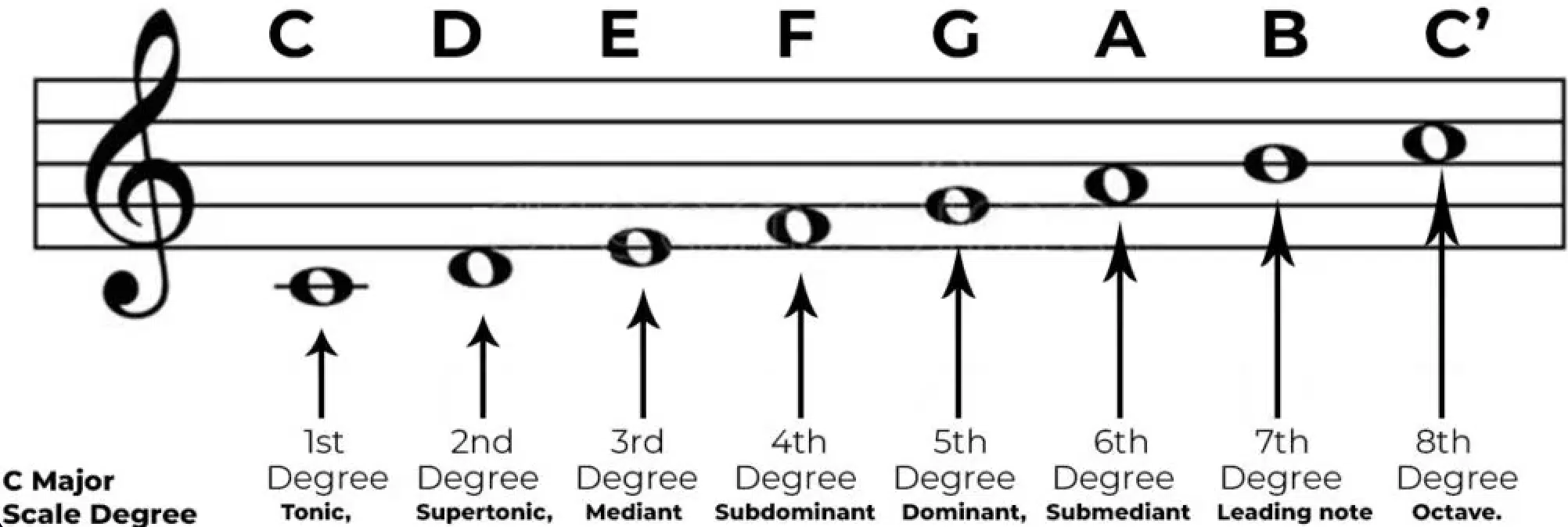
When it comes to understanding how major chord progressions work, the key of C major is a great starting point.
It’s considered the most basic key in music because it doesn’t have any sharps or flats, which also makes it much easier to see exactly how the chords fit together.
In the key of C major, each chord is built from the major scale, starting with:
- The C major chord (as the I chord)
- D minor (ii)
- E minor (iii)
- F (IV)
- G (V)
- A minor (vi)
- B diminished (vii°)
The primary chords here are C (I), F (IV), and G (V), and these primary chords play a major role in creating a sense of stability/movement within the progression.
The V chord (G) is super important too because it adds tension that makes the return to the I chord feel more satisfying.
In the key of C major, a classic progression like I-IV-V (C-F-G) shows how these chords interact 一 with the V chord leading the progression forward.
Major Chords vs. Minor Chords: Breaking Down the Differences
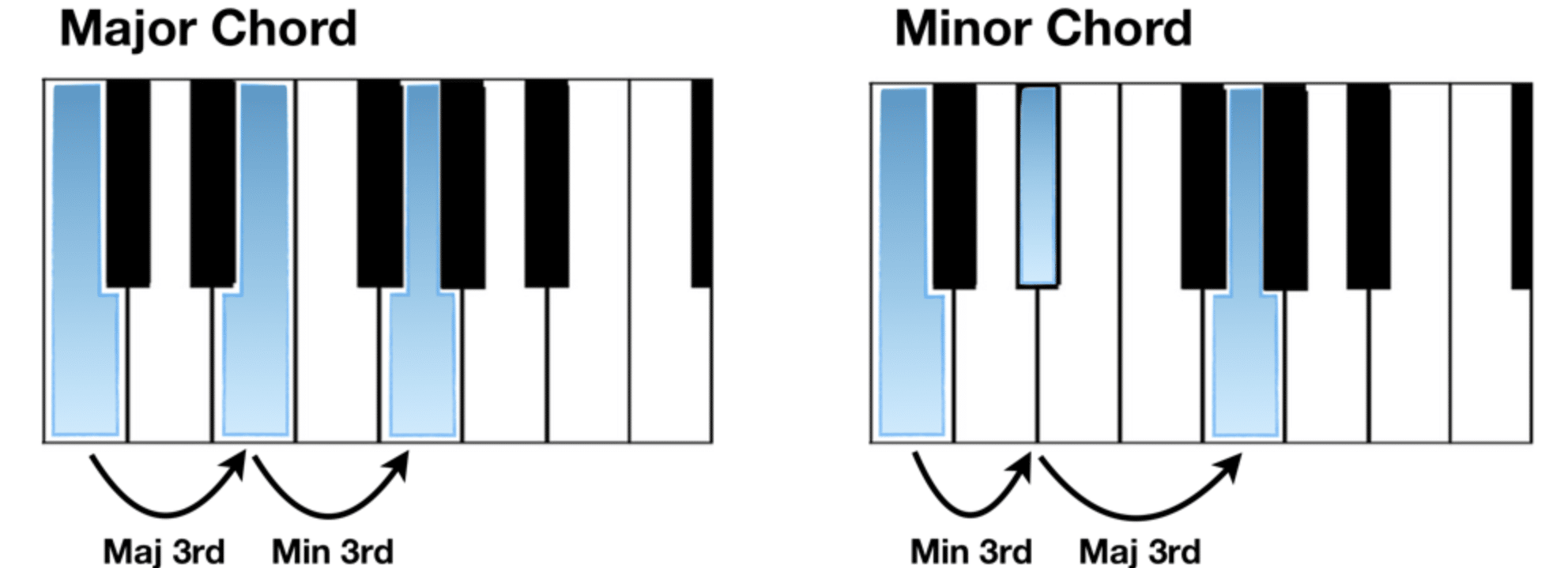
Major chords and minor chords may seem similar, but they create completely different vibes/moods in music.
Understanding the differences between the two can not only skyrocket your theory skills, but also help you convey the emotion you’re going for much better.
Major chords, like C Major (C-E-G), typically sound bright and happy, and minor chords, like A Minor (A-C-E), feel darker and more emotional.
This difference all comes from the third interval…
Major chords use a major third, while minor chords (like the natural minor scale) use a minor third, which is one semitone lower.
For example, in the harmonic minor scale, the raised 7th (like G# in A harmonic minor) adds tension that you really won’t find in the major scale.
The melodic minor scale is even more complex, with a raised 6th and 7th 一 giving it a ‘fancier’ sound compared to the major scale if that makes sense.
In a minor key, progressions like i-iv-V (A minor-D minor-E) highlight the darker tone when compared to the I-IV-V progression in a major key (like C-F-G in C Major).
NOTE: On that same note, using minor chords in a minor key can create a sadder, depressed atmosphere, perfect for genres like R&B or lo-fi.
So, whether you’re using major or minor chords, now you know how exactly each one brings a distinct color to your common chord progressions.
Side note, if you want to learn all about intervals, we got you covered.
Using A Chord Progression Chart
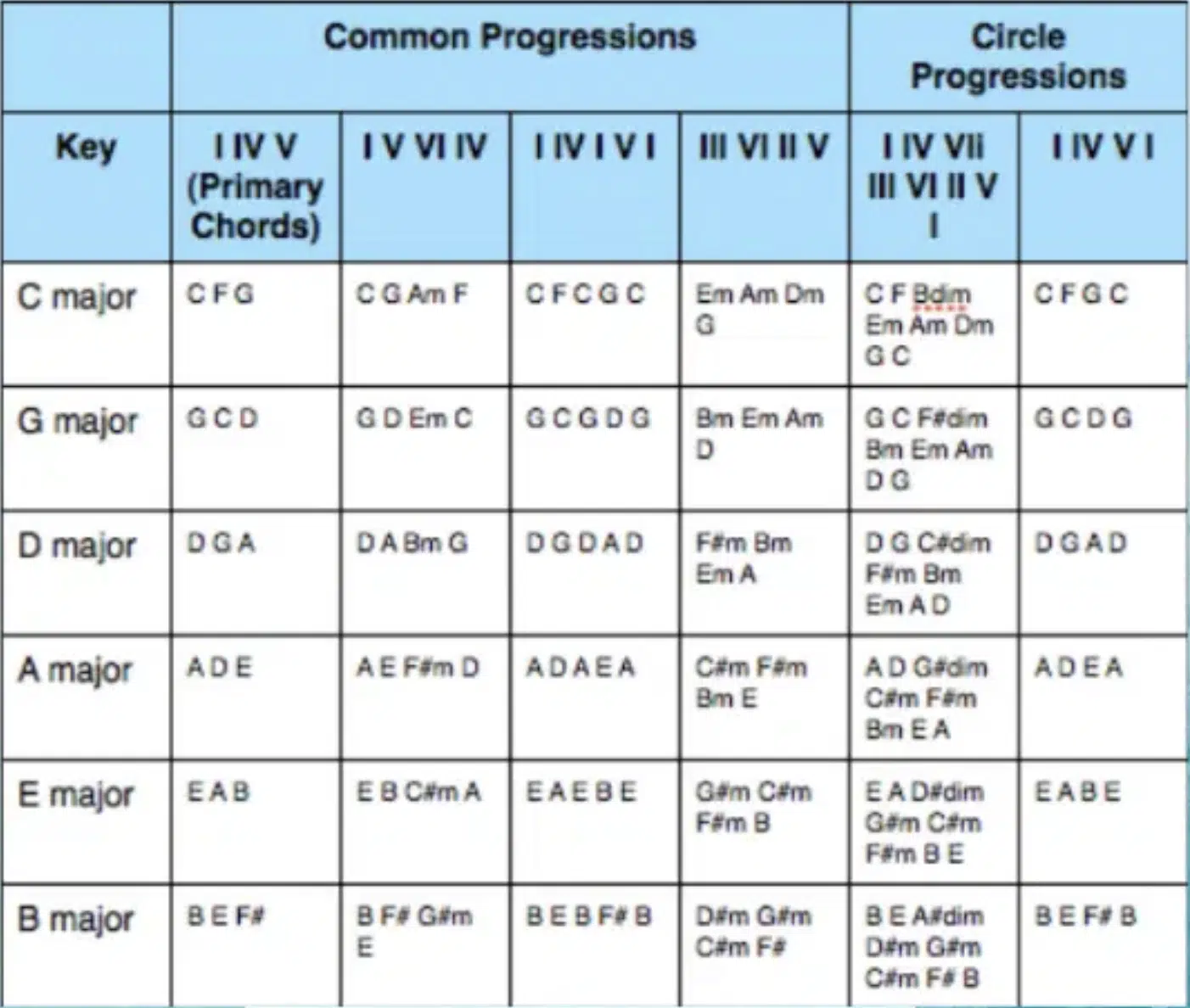
A major chord progression chart (or any chord progression chart, really) is one of the best tools you can have when enhancing many songs.
#1. A chord progression chart visually lays out the relationships between chords within a key, showing you how to build progressions like I-IV-V (e.g., C-F-G).
Or, even slightly more complex patterns like I-vi-ii-V (C-Am-Dm-G), which introduces the minor vi chord for added impact.
#2. To take it a step further, you could even add extensions to these chords, such as turning the G Major (V) into G9 (G-B-D-F-A).
This kind of chart not only helps you understand which chords fit together naturally, but also how they create different vibes 一 from bright and uplifting to super soulful.
#3. For even more variety, you can use the major chord progression chart to explore less common progressions, like I-iii-IV-V (C-Em-F-G) in the key of C Major.
The iii chord adds a slight touch of sadness 一 making the chord progression feel unique while still maintaining the major tonality.
#4. You could also use inversions that are listed on the chart.
For example, in the I-vi-IV-V progression (C-Am-F-G), playing Am/C and F/A as inversions can create a smoother bassline.
It gives it a more fluid, professional feel that I personally find super intriguing.
#5. Major chord progression charts are also great for modulating between keys. Let’s say you’re working in the key of D Major and want to shift to a different key for the chorus…
The major chord progression chart makes it easy to spot a common pivot chord, like the V chord (A Major), which can be used to transition smoothly into the key of A Major.
This kind of modulation can create a dope lift for some extra excitement.
Bottom line, whether you’re creating an upbeat pop hook or a laid-back R&B track, the major chord progression chart helps you play around with new, exciting arrangements.
Popular Chord Progressions in Major
When we’re talking about popular songs, major chord progressions are all over the place. As you now know, they’re used to create familiar, catchy, and uplifting vibes that listeners get addicted to. Some of the most popular chord progressions in major keys offer a foundation that’s easy to work with, while still giving you room for creative tweaks. So, now that you know how to use major a chord progressions chart, let’s break down some of the most popular chord progressions around.
#1. The I-IV-V Chord Progression
The I-IV-V chord progression is the most common chord progression (popular chord progression) in the game, respectively.
It creates a strong, complete sound that feels both familiar and insanely satisfying 一 in the key of G Major, this chord progression would be G (I) – C (IV) – D (V).
The I chord acts as the “home” base, the IV chord adds lift, and the V chord introduces tension that naturally resolves back to the I chord.
If you’re looking for a straightforward, happy, and powerful vibe, this one is a go-to (especially for choruses and bridges in your song).
If you’re working with this progression, try using different inversions to create smoother transitions, like playing C/G instead of C to lead back to the G chord.
A great example of this progression in modern music is “Let It Be” by The Beatles, where the I-IV-V pattern drives the entire song, making it iconic and uplifting.
#2. The I-V-vi-IV Chord Progression
The I-V-vi-IV chord progression is one of the most popular chord progressions out there as well, and it’s really not hard to see why.
In the key of C Major, this chord progression is C (I) – G (V) – A minor (vi) – F (IV).
It starts off bright with the I chord, adds a bit of tension with the V chord, dips into the emotional A minor chord (vi), and then wraps up smoothly with the F Major chord (IV).
What makes this chord progression special is how it creates a mix of energy and emotion in a very short time, which makes it perfect for catchy choruses in pop or trap.
When working with this progression, try adding a subtle vocal pad on the vi chord to enhance its emotional pull 一 it’s a technique I use to keep listeners hooked.
One of my favorite tracks that uses this chord progression is “Closer” by The Chainsmokers, which really nails that blend of upbeat and melancholic vibes.
#3. The I-vi-IV-V Chord Progression
The I-vi-IV-V chord progression brings a slightly different feel compared to other chord progressions that we’re talking about today.
In G Major, it’s structured as G (I) root note – E minor (vi) – C (IV) – D (V).
It starts with the strong, happy I chord but then shifts into the more introspective vi chord, giving it a more soulful touch.
But then, it lifts back up again with the IV and V chords.
This unique combination creates a perfect balance of ups and downs 一 making this particular chord progression a favorite for R&B and some pop tracks.
You’ll want to use this common chord progression when creating a sense of longing or hope (it’s super emotional, just think of any NF songs, great examples).
If you’re trying this chord progression out, a great way is to add a light touch of reverb on the vi chord.
It helps amplify its emotional impact without losing any momentum.
Ed Sheeran’s “Perfect” is a great example of how this chord progression can create a warm, romantic atmosphere that reels you in right off rip (and sticks with you after).
#4. The I-IV-vi-V Chord Progression
The I-IV-vi-V chord progression has a slightly different flavor from other major chord progressions as well (I guess you can tell I like the more ‘unique’ ones).
In D Major, this would be: D (I) – G (IV) – B minor (vi) – A (V).
It kicks things off with:
- The uplifting I chord
- Lifts further with the IV chord
- Then. adds some emotional depth with the vi chord
- Finally creates a sense of closure with the V chord
I’ve found that this chord progression works wonders when you want a mix of inspiration and passion, especially in popular songs that aim to be an anthem with major chords.
You know, super motivating and gets you really hyped up.
If you’re using this chord progression, try adding a low-pass filter sweep on the vi chord; it helps create a cool transition into the V chord and keeps the energy flowing.
One of my go-to examples for this specific chord progression is “Grenade” by Bruno Mars, which uses it to deliver both intensity and a catchy chorus.
#5. The I-IV-ii-V Chord Progression
The I-IV-ii-V chord progression stands out among other chord progressions because of its use of the ii chord 一 adding a bit of unexpected tension.
In F Major, this chord progression is: F (I) root note – B♭ (IV) – G minor (ii) – C (V).
The ii chord makes the progression feel slightly more sophisticated, which gives it a jazzier vibe that works well in R&B or neo-soul tracks.
I like to add this chord progression to slower tracks where I want to keep things interesting without shifting keys altogether.
NOTE: Try to play the ii chord as a Gm7. It adds a smoother transition to the V chord, giving the progression a more layered feel.
One of my favorite tracks that uses this chord progression is “Versace on the Floor” by Bruno Mars, which is super underrated if you ask me.
It’s a perfect example of how this common chord progression can create a smooth, romantic sound that still feels engaging (think: cloud nine).
#6. The I-iii-IV-V Chord Progression
The I-iii-IV-V chord progression is a unique twist among major chord progressions, as it incorporates the iii chord for a surprising hint of minor tonality.
In the key of G Major, this chord progression is G (I) – B minor (iii) – C (IV) – D (V).
Starting with the bright I chord, it then dips into the minor iii chord 一 introducing a touch of complexity before ending with the IV and V chords.
This major chord progression is great for adding some extra emotional depth to your tracks without losing the overall major feel.
One tip for working with this chord progression is to try adding a delay effect to the iii chord which gives it a sick haunting quality that makes it stand out.
One of the best examples of this chord progression is in the song “Stay With Me” by Same Smith, where it creates an almost pleading vibe that’s hard to forget.
#7. The I-V-IV-V Chord Progression
The I-V-IV-V chord progression is simple and straightforward but it’s actually pretty impactful because it adds a powerful sense of movement.
In C Major, this would be first note: C (I) – G (V) – F (IV) – G (V).
What sets this progression apart from other major chord progressions is the repetition of the V chord, which keeps the energy high.
It makes the progression feel circular, which is perfect for dance tracks or different songs that aim to be very upbeat and exciting.
I’ve used this common chord progression in several of my own projects, especially when I want to build intensity and keep listeners on their toes.
If you’re experimenting with this progression, try using a synth lead on the IV chord to emphasize its lifting effect before bringing back the V chord for a punchy finish.
“Shake It Off” by Taylor Swift uses this exact progression, so you can imagine how catchy and danceable you can make your song.
#8. The I-V-I Chord Progression
The I-V-I chord progression is one of the simplest but also one of the most satisfying major chord progressions thanks to its incredibly strong sense of resolution.
In the key of F Major, this progression would be F (I) – C (V) – F (I).
The quick return to the I chord after the V chord makes it feel complete and resolved, often giving many songs a more traditional or classical feel.
This can be refreshing and is actually pretty popular in more modern tracks 一 I use it sometimes when I want a clean, conclusive ending to my track.
One great trick is to add a sub-bass under the V chord to create tension before heading back to the I chord.
It’s a subtle but powerful way to make the progression feel even stronger.
“Thinking Out Loud” by Ed Sheeran uses the I-V-I progression to deliver that classic love ballad feel, which you can hear above.
#9. The I-vi-ii-V Chord Progression
The I-vi-ii-V chord progression is a popular choice for creating a smoother, jazzier feel in major chord progressions.
In the key of A Major, it would be A (I) – F# minor (vi) – B minor (ii) – E (V).
What makes this common chord progression special is the way it gradually builds tension from the ii chord to the V chord.
It’s perfect when you’re setting up for an emotional chorus or bridge.
I like to use this progression when I’m working on an R&B or neo-soul vibe the most because it flows nicely and keeps the track feeling relaxed yet intriguing.
NOTE: Try to play the vi and ii chords as 7th chords, like F#m7 or Bm7, to give the chord progression a more laid-back/chill vibe.
You can hear this progression in “All of Me” by John Legend, where it perfectly complements the song’s romantic and intimate vibe.
Creating Your Own Major Chord Progressions (Key Steps)
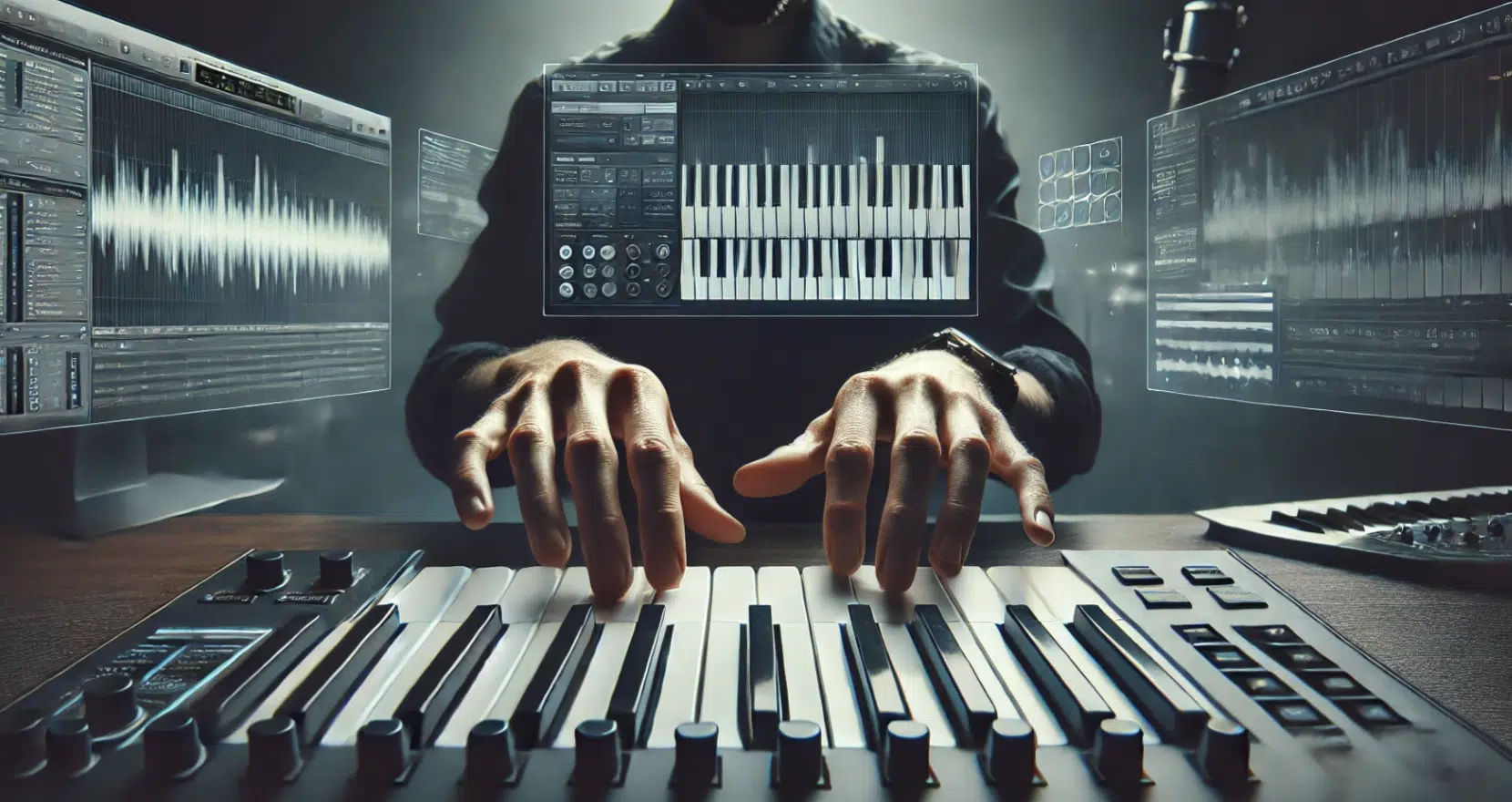
As producers, creating your own major chord progressions is pretty much non-negotiable (I mean, you can use AI chord generators, but you know what I mean).
It all begins with selecting a key and understanding the diatonic chords within that key.
Let’s say you choose the key of C Major, which includes C (I), D minor (ii), E minor (iii), F (IV), G (V), A minor (vi), and B diminished (vii°)…
Start by picking an anchor chord, usually the I chord, as it establishes a strong foundation and sets things up for you to build off of perfectly.
From there, you can experiment by adding the IV or V chord to introduce a sense of lift or tension which is hallmark.
For even more depth, try including the vi chord, which brings a minor chord touch 一 making the progression more emotional.
For example, a common progression like I-V-vi-IV in C Major would be C-G-Am-F.
NOTE: To add variation, use inversions, such as playing F/C (IV) instead of F, to create flawless transitions.
You can also experiment with rhythm, which is a personal favorite of by syncopating the V chord or holding the vi chord longer to change the progression’s groove/feel.
The key is to experiment with different combinations, voicings, and polyrhythms until you create a progression that captures the exact vibe you’re going for.
-
Pro Tip
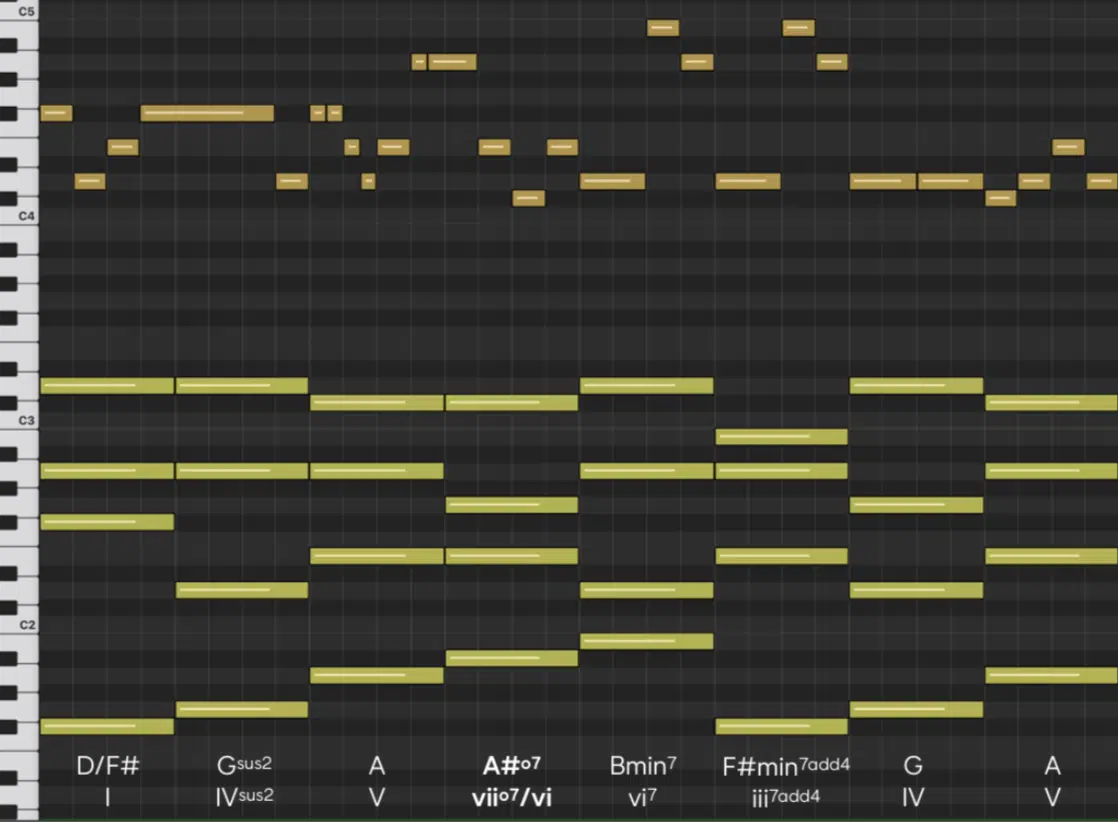
When working on piano chord progressions, try adding diminished chords (above) to introduce unexpected tension and movement.
In the key of C Major, try using B diminished (vii°) as a passing chord between C (I) and D minor (ii) to create a more dramatic progression.
Another technique when you write chord progressions/piano chord progressions is to use a diminished chord from the harmonic minor scale, like G# diminished.
This will add a darker, more intense vibe to your piano chords, which sounds sick.
It not only adds depth to your common chord progressions but also makes them feel more dynamic and engaging all around.
Remember, when you create chord progressions that need to stand out, it’s all about incorporating unique, out-of-the box variations (no basic ish here).
Bonus #1. Layering Major Chords with Pads or Synths
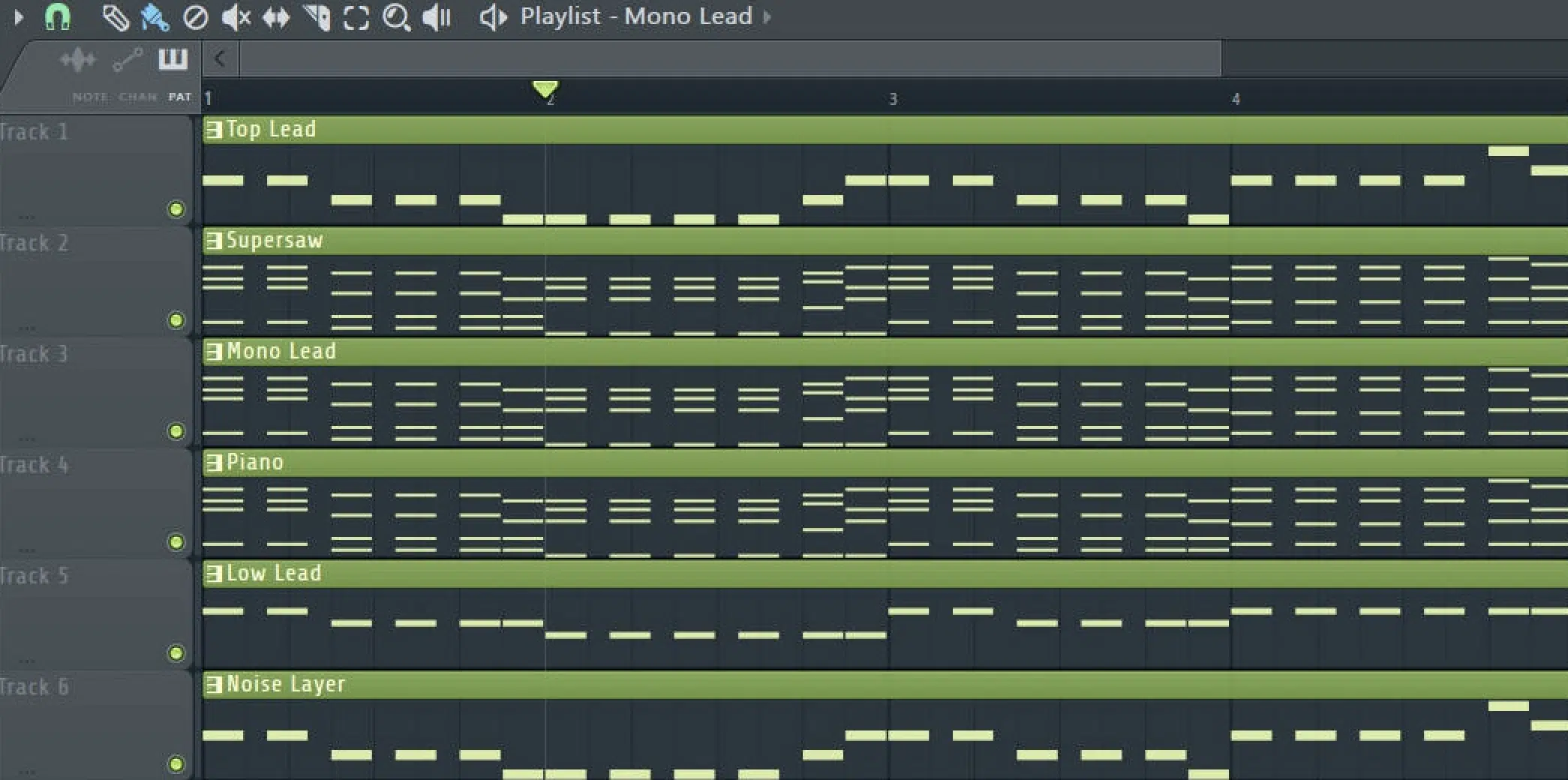
Layering major chords with pads or synths can add warmth, depth, and a sense of space to your chord progressions.
For example, when you’re working with a simple I-IV-V progression in the key of C Major (C-F-G), adding a soft pad underneath can give the chords an immersive/grand feel.
I like to use a warm synth pad with a slow attack and release to make the progression feel more fluid and smooth (especially in genres like pop or lo-fi).
To add more texture, try layering a pluck synth on the V chord, which can create a nice contrast before going back to the I chord.
My personal trick is to use a slightly detuned saw wave on the IV chord 一 giving it a wider stereo image, which makes the whole progression feel more expansive.
Don’t forget to adjust the ADSR settings on the synths to make sure they blend perfectly and avoid any clashing with other layers in the mix.
Bonus #2. Extending Major Chords for Show-stopping Sounds
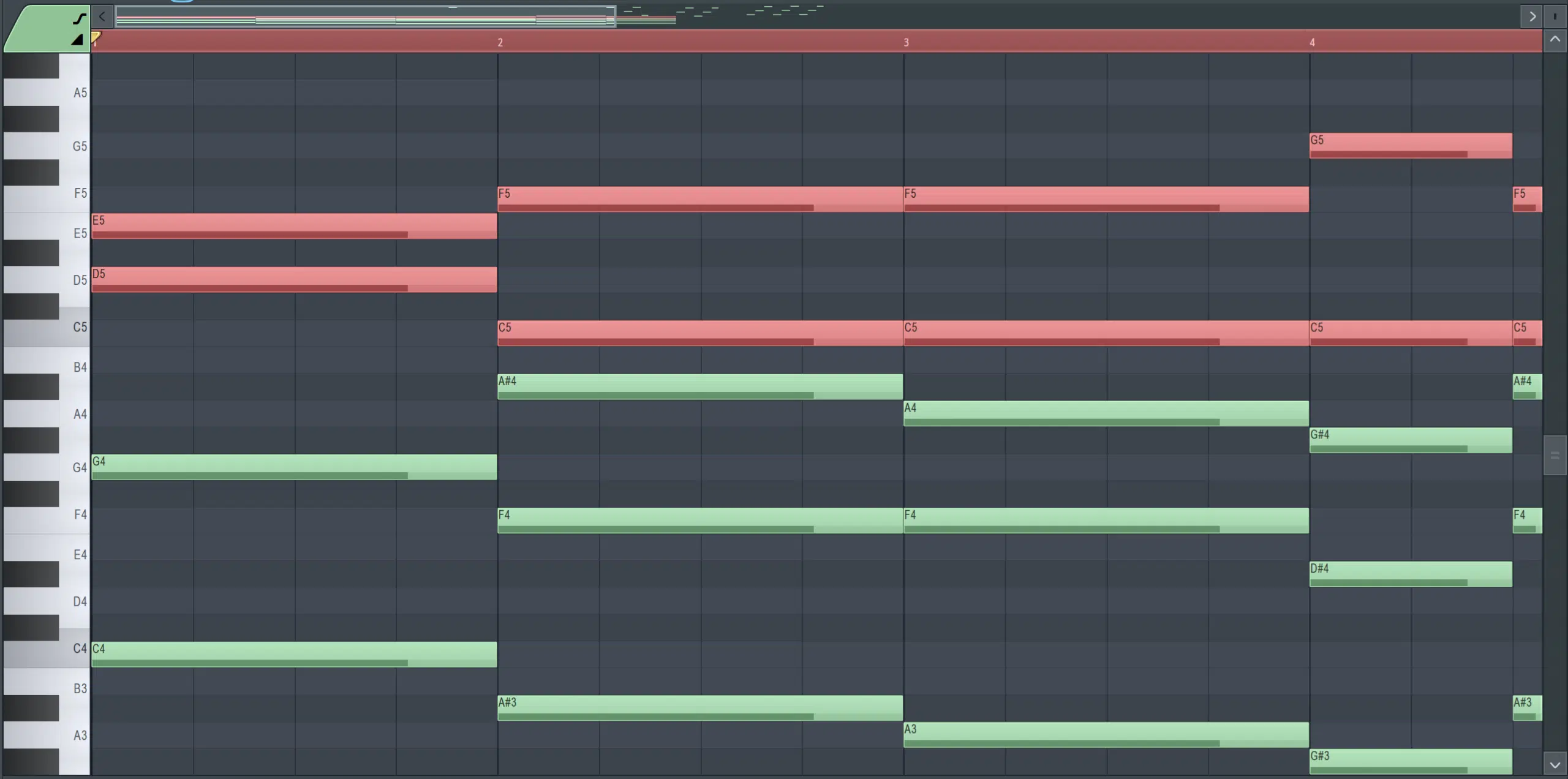
Extending major chords can make your chord progressions sound richer and more captivating with extensions like:
- Sevenths (7ths)
- Ninths (9th)
- Thirteenths (13th)
- Etc.
They all add extra notes to the more basic major triad, giving the chords a more colorful, bright, loud feel.
For example, turning a C Major chord into Cmaj7 (C-E-G-B) adds a cool, laid-back vibe or adding a 9th to the IV chord in the key of G Major (Cmaj9: C-E-G-D) creates depth.
I use this technique to add character to the I chord 一 turning G Major into Gmaj9 or Gmaj13 for a more expressive feel.
PRO TIP: Try using extended chords at the end of your progression, like resolving to a Dmaj7 instead of a plain D Major which adds a surprisingly quality that’s dope.
Major Chord Progression Chart: Final Thoughts
Mastering major chord progressions can be a little overwhelming, but it just takes some time, practice, and a basic understanding of music theory.
However, using a major chord progression chart and the techniques we covered today can significantly enhance your workflow and make the process super simple.
Plus, they help you build, refine, and expand your progressions with ease so you never get stuck or feel uninspired (and defeat beat-block every time).
It’s all about finding the right balance between structure and creativity.
For truly next-level results and a better understanding of what we’re talking about today, you have to check out this invaluable Essential Advanced MIDI Chord Progressions pack.
It comes pack with 24 unique, royalty-free MIDI chord progressions that are designed to elevate your tracks beyond the basics.
These advanced progressions are easy to plug and play into your DAW 一 making them even more versatile than any major chord progression chart you can find.
Whether you’re aiming for a hit pop single, a soulful R&B groove, or even an experimental electronic track, this MIDI pack gives you unmatched inspiration.
It can help you achieve professional-sounding tracks faster than ever.
Bottom line, mastering major chord progressions is key to producing compelling tracks and chord charts are great learning tools to get you started or build your skills.
Just make sure to practice regularly, experiment with extensions and modulations, and let the major chord progression chart guide your creativity.
This way, you’ll consistently knock out music that stands out and your listeners want to listen to over and over again.
Until next time…







Leave a Reply
You must belogged in to post a comment.